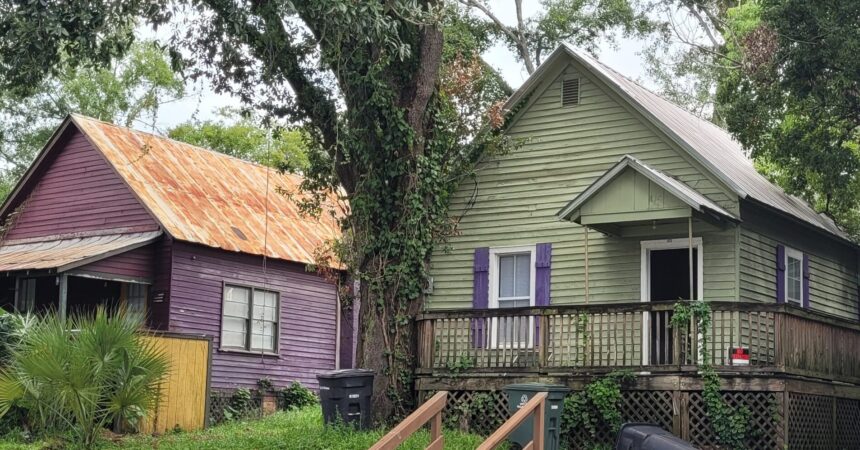
Effort underway to save houses loaded with Black history

Photo by St. Clair Murraine
By St. Clair Murraine
Outlook Staff Writer
Two houses tied to some deep-rooted Black history in Tallahassee is fast approaching the 11th hour to avert demolition, a fate that a group is anxiously trying avoid.
The houses – one painted green and the other burgundy – are located at 672 and 674 West Saint Augustine Street. That’s in the heart of College Town, where developers Landmark Properties plan to build student housing.
The developers that own the property where the houses sit, have given the group until Friday to move them out. However, they are optimistic they’ll be able to buy a little more time if needed.
“Saving these two historic homes will help illuminate the rich history of Black people who contributed to Tallahassee’s growth and prosperity,” said historian Priscilla Hawkins in a press release. “These houses possess significant historical value regarding the architectural style and materials used for home-building in Tallahassee during the early 1900s – more than 100 years ago.
“Each stands as a commitment by early residents of their love for this city; and their hopes for building their families’ lives in this place they chose to call home.”
The original size of the houses were 20 feet by 30 feet before additions were put on. They were owned by Willis Jiles. His story of being an entrepreneur who owned Jiles Shoe Factory, is documented by Florida Memory.
Jiles’ contributions to the Tallahassee economy in the early 1900’s is featured in an exhibit in the old Freedman’s Bank building that is now a museum located near Apalachee Parkway and Monroe Street. Ironically, Jiles had his shoe operation in a part of the same building when it was a bank at another downtown location.
The two houses in College Town were property that Jiles rented to tenants before he lost them in a tax sale. They apparently changes hands again before Landmark Properties purchased them.
As word of the developers’ plan got around, Max Epstein, an environmentalist who is also a researcher at the DeVoe Moore Center, started a social media thread in hopes of saving the houses. Jiles’ granddaughter Jacquelyn Dupont, Hawkins and Havana businessman Jose Tapia joined the effort.
“As a Tallahassee citizen, it’s important to me to preserve our history so we know where we are coming from,” Epstein said, explaining his interest. “We are losing too much of it over the years.”
Tapia seemingly has the most important role in the effort to move the houses. He’s expressed a willingness to finance the relocation and repurpose the structure to be used as affordable housing.
Epstein called Tapia “an angel investor,” who is willing to put up more than $80,000 to move the houses. Restoring old houses is in Tapia’s wheelhouse. He currently owns a proper made up of 12 repurposed houses in Havana that were built between 1928-1930.
“I was intrigue and want to do what I can to save the structures,” said Tapia, who uses his property as a wedding venue. “We have to figure out a way to make it work and make it make sense.”
As of this past Monday, the group hadn’t nailed down a site for relocating the houses. They are hoping to negotiate an agreement to use city-owned property near the corner of Wales Street and FAMU Way. Other locations in the vicinity are also being considered, Epstein said.
With this being crunch time, Dupont, who works as a community based developer of affordable housing in California, said the situation is “right up my alley.”
Dupont is the daughter of Eleanor and King Solomon Dupont, who is the son in-law of Jiles. Her father was also the first Black person to run for an elected office in Tallahassee City Commission seat in 1957.
“The Jiles houses tell their own stories, but they should be the place where other stories are told,” Dupont said. “Not only the story of Willis Jiles but all of the other people who contributed to the history of Tallahassee who may never have an opportunity for their families to share that story.
“I do believe it will work out. I don’t work in atmosphere where you have time. In development you don’t have time; you’re always under a deadline so this is similar to what I do.”







